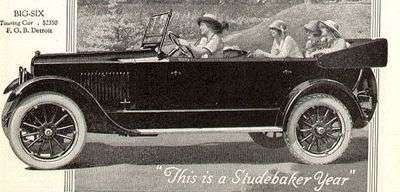Touring car
Touring car and tourer are both terms for open cars (i.e. cars without a fixed roof).

"Touring car" is a style of open car built in the United States which seats four or more people. The style was popular from the early 1900s to the 1920s. The cars used for touring car racing in various series since the 1960s are unrelated to these early touring cars, despite sharing the same name.
"Tourer" is used in British English for any open car. The term "all-weather tourer" was used to describe convertibles (vehicles that could be fully enclosed). A popular version of the tourer was the torpedo, with the hood/bonnet line at the car's waistline giving the car a straight line from front to back.
Touring car (U.S.)
Design


"Touring car" was applied in the U.S. to open cars (cars without a fixed roof, for example convertibles) that seat four or more people and has direct entrance to the tonneau (rear passenger area),[1] although it has also been described as seating five or more people.[2] Touring cars may have two or four doors, and the drivetrain layouts of early touring cars was either front engined or mid-engined.
When the top was folded down, it formed a bulky mass known as the "fan" behind the back seat: "fan covers" were made to protect the top and its wooden ribs while in the down position. Some touring cars were available with side curtains to protect occupants from wind and weather by snapping or zipping them into place; otherwise, the occupants had minimal weather protection.
History
The touring car body style was popular in the early 20th century, being a larger alternative to the two-seat runabout and the roadster. By the mid-1910s, the touring car body had evolved into several types, including the four-door touring car which was equipped with a convertible top.[3][4]
Most of Model T's produced by Ford between 1908 and 1927 were four and then three-door models (with drivers sliding behind the wheel from passenger seat) touring cars, accounting for 6,519,643 cars sold out of the 15,000,000 estimated Model T's built. This accounted for 44% of all Model T's sold over the model's eighteen-plus year life span, making it the most popular body style.
The popularity of the touring car began to wane in the 1920s when cars with enclosed passenger compartments (i.e. fixed steel roofs) became more affordable, and began to consistently out-sell the open cars.[5]
Tourer in British English
Tourer is used for open cars.[6]
The belt lines of 1930s tourers were often lowered at the front doors to suggest a more sporting character.[7]
All-weather tourer (just as in the U.S.) are cars with high quality tops and wind-up side-windows;[8] they were later called convertibles.[9]
_(4330958482).jpg) 1927 Austin 20 tourer- front (without side curtains)
1927 Austin 20 tourer- front (without side curtains).jpg) 1927 Austin 20 tourer- rear
1927 Austin 20 tourer- rear.jpg) 1951 Ford Anglia tourer- note the lowered beltline at the front door
1951 Ford Anglia tourer- note the lowered beltline at the front door
Torpedo body
The torpedo was a style of 4-seat or 5-seat tourers built from 1908 until the mid-1930s.[10] The design consists of a hood/bonnet line raised to be level with the car's waistline, resulting in a straight beltline from front to back.[11]
See also
- Barchetta – an Italian style of roadster or spyder developed for racing cars after World War II
- Phaeton body – similar to a touring car, but initially lighter and more sporting
- Runabout – a light, open two-seat car, similar to a roadster but with emphasis on economy instead of performance.
References
- "What's What in Automobile Bodies Officially Determined" (pdf). The New York Times. New York, NY USA. Nomenclature Division, Society of Automobile Engineers. August 20, 1916. ISSN 0362-4331. OCLC 1645522. Retrieved 2012-05-31.
Here it is, with other body types and distinctions, officially determined recently by the Nomenclature Division of the Society of Automobile Engineers:
- Stein, Jess, ed. (1975) [1968]. The Random House College Dictionary (Revised ed.). New York, NY USA: Random House. p. 1389. ISBN 0-394-43600-8.
touring car, an open automobile designed for five or more passengers.
- "1927 Ford Model T Touring (Fifteen-Millionth Ford)". www.historicvehicle.org. Retrieved 9 November 2018.
- "The Automobiles". www.fountainheadmuseum.com. Retrieved 9 November 2018.
- Ullman, William (1930-01-19). "Show Reflects Car's Progress – Dawn of New Decade Finds Motordom Has Made Gigantic Strides". The Pittsburgh Press. Pittsburgh, PA USA. Automobile Section. Retrieved 2012-06-02.
Interest was centered in the development of low-priced closed models in every automobile factory in the country and the rapid decline of the open car was apparent on all sides.
- Tourer. Ian Beattie. "The complete book of Automobile Body Design, March 1977, Haynes, Yeovil. ISBN 0854292179
- Davis, Pedr., ed. (1986). The Macquarie Dictionary of Motoring. Sydney, Australia: Macquarie Library. p. 485. ISBN 0-949757-35-7.
- Georgano, G. N.; Andersen, Thorkil Ry (1982-10-21) [1973]. Georgano, G. N. (ed.). The New encyclopedia of motorcars, 1885 to the present (3rd ed.). Dutton. p. 685. ISBN 0-5259-3254-2. Retrieved 2012-08-12.CS1 maint: ref=harv (link)
- Georgano & Andersen 1982, p. 683.
- Georgano, G. N., ed. (1971). "Glossary". Encyclopedia of American Automobiles. New York, NY USA: E. P. Dutton. p. 217. ISBN 0-525-097929. LCCN 79-147885. Retrieved 2012-08-12.
- Roberts, Peter (1974). "Carriage to Car". Veteran and Vintage Cars. London, UK: Octopus Books. p. 111. ISBN 0-7064-0331-2.
Torpedo – Continental term for an open four-seat tourer with soft hood and sporting tendencies and in which the line of the bonnet was continued back to the rear of the car.